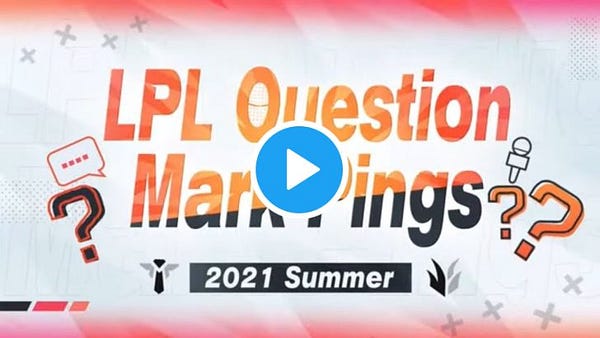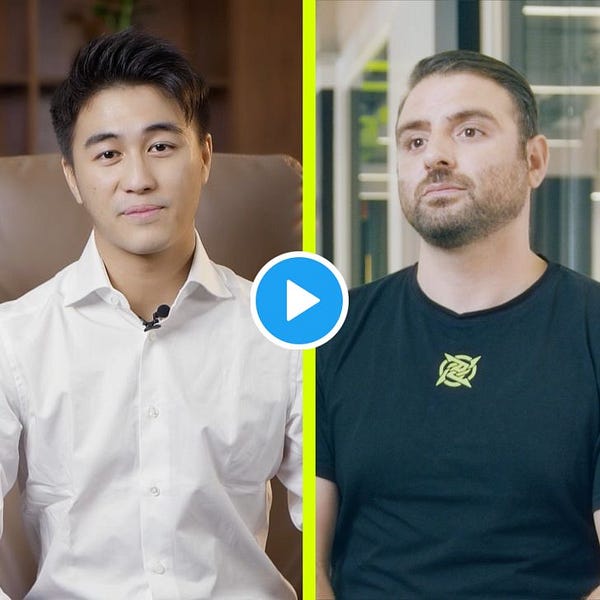Hello Esports Enthusiasts!
It’s been a minute, but things have been getting really interesting lately in Chinese esports and I wanted to share.
Not appearing in today’s issue, but possibly in the next: the Huya/Douyu breakup, the current “Sky is Falling” narrative about the China’s tech industry, and how those might impact esports. These are big topics and I have thoughts! For now I’ll just say I am not betting on China’s esports industry folding up its tent.
Follow me on Twitter at @ChinaEsportsBiz. Got questions? DMs are open.
- John Oliverius
⚠️Nothing in this newsletter is intended or should be construed as financial or legal advice.
▶️ The Next Thing in Esports: Multinational Clubs
While everyone else in the gaming sector was getting spooked by China over the last two weeks, two major western esports organizations made contrary moves by physically moving into China’s esports market.
First, Evil Geniuses (EG) became the first esports org to operate teams across North America, Europe, and China, via a partnership with Fosun Sports’ Woverhampton Wanderers FC, which includes the partly China-based Wolves Esports. Fosun Sports becomes a minority investor in EG, with the two orgs combining forces for content, marketing, sponsorship, merchandise, and training facilities.


11 days later, Sweden-based Ninjas in Pyjamas upped the ante and announced a merger with Wuhan-based eStar Victory Five (ESV5), to form the NIP Group (the Chinese version 星威忍者集团 adds “star” from eStar, making me wish they decided to call it the Ninja Stars, but no one asked). NIP will take over V5’s operations and brand, as well as launch a NIP-branded Wild Rift team, leveraging the mobile esports expertise and resources of KPL powerhouse eStar Gaming.
Valuable league seats headlined both transactions, as EG’s LEC team will now get a second home in China and Wolves co-branding, while NIP becomes the first foreign-branded LPL team. The full list of combined titles in each transaction layer nicely without any obvious conflict of interest: by my count, the combined EG/Wolves will operate teams in LOL (LEC), Dota2, CS:GO, Valorant, COD Mobile, FIFA, FFO4, Identity V, 5th Personality, and Rocket League. NIP/ESV5 will operate teams in LOL (LPL), KPL, Crossfire, QQ Speed, CS:GO, Rainbow 6 Siege, FIFA, and Valorant, and Wild Rift. The only tier one esports missing here are the PC and mobile PUBG titles, and any Blizzard Activison titles (COD Mobile esports is operated by Tencent).
That western orgs and their sponsors want access to China’s massive esports audience, while Chinese orgs want to differentiate themsleves by growing beyond the local market, is not surprising: see Paris St. Germain’s co-branding tie-ups with LGD Gaming and Talon Esports. What’s new is that top tier esports orgs everywhere have come to the consensus that only “global brands” will have sufficiently diversified revenue streams to survive, as empahsized by ESV5 CEO Mario in this interview (Chinese). These orgs could have established a virtual presence across borders through local agencies and co-branding deals, but they decided instead to take more radical steps, perhaps presaging future cross-border partnerships or even M&A among esports orgs.
▶️ Rating China’s Top Esports Cities
At Chinajoy last month, the China Audio-video and Digital Publishing Association [中国音像与数字出版 ] (“CADPA”) released a data-driven index of the top 10 esports cities in China, looking at the quantity and quality of esports enterprises, esports industrial parks, major esports events, and local clubs.
True to its “global esports capital” moniker, Shanghai was overall high at the top of the list, despite some movement of esports organizations to other tier 1 and 2 cities. CADPA rated Shanghai, Beijing, and Guangzhou at the top of the list for favorable esports development policies (like subsidies), followed by Chengdu, Haikou, Shenzhen, Xi’an, Chongqing, Nanjing, and Fuzhou. The top 3 cities also rated highest for compensation.
This list did not however align with the top 10 cities by interest and enthusiasm in esports, as measured by CADPA: Nanjing, Guangzhou, Wuhan, Tianjin, Shenzhen, Foshan, Haikou, Taiyuan, Hangzhou, and Ningbo. These are basically a mix of tier 1, “new tier 1”, and tier 2 cities. A few months ago I chuckled at Tianjin’s inclusion in what I thought was a pretty off-base list of the “hottest esports cities” in China, but maybe I’m behind the times!
For a closer look at the efforts that three cities, Xi’an, Harbin and Guizhou, are making to integrate esports with their local cultural attibutes to boost tourism, read this column by Gyro Esports (Chinese reading skills or a good web translator required).
▶️ Foshan Doubles Down on Esports
Foshan was an early player in the 2019 flurry of esports development programs announced by various major cities across China (which I chronicled here and here). Two years later, Foshan has launched version 2.0 of its esports support policies, again focused on the Nanhai District Esports Culture and Creative Industrial Center [南海电竞文创产业中心], including a ¥100M RMB / $15.4M USD contribution to the site, rent subsidies for sited esports enterprises, and 30% subsidies for investments in new esports venues. As with similar projects in other cities, the goal is to cultivate “cultural tourism” and so-called digital cultural industries such as esports, animation, and gaming.
▶️ Competing in the LPL is a Tough Gig
PentaQ (great source for LPL news, btw) recently interviewed LPL and PCS players and coaches about their training regime and rest, lately a hot topic in esports everwhere. Bottom line: life in the LPL is hardcore. No surprise there — remember this is the league that left its most famous star, Jian “Uzi” Zihao, with career-ending arm damage. It also left him one of the most famous 20-somethings in China, and very rich. According to the interview, there is universal acknowledgement that this is simply the cost of competing in the premier esports league in the world.
Here’s the LPL English video that prompted the story:


In other “are you sure you want to be an esports pro” news, an LPL jungler for Victory Five was fined a month’s salary for forgetting to pick “smite” (essential for the jungler role) before a match, contributing to the team’s loss. Considering that V5 ended the summer split with a 0-13 record, it seems a bit much to levy such a harsh punishment, regardless of how egregious the mental error…
▶️ Speaking of Tough Jobs: Bixin’s Peiwan
Protocol did an interesting deep dive on gaming virtual companions in China, or “peiwan” [陪玩] (h/t Niko Partners). The majority of peiwan make their living on Bixin, a platform for virtual coaching and esports training that I’ve profiled before. Bixin was even selected as the official platform for certification of esports trainers in Shanghai, and it is a leading sponsor of esports organizations in China. There are many different virtual coaching platforms outside China, but to my knowledge only in China is game companionship a significant revenue segment of the online economy, considered part of the same industry as livestreaming. But like it or not, this seems like a digital trend that can easily grow abroad.
▶️ Get on Your Steel Horse and Ride
Good news for competitive agriculturalists: Season 3 of the Farming Simulator League (FSL) will return to live events, to be held in Germany this August and September. How the heck is this a China esports story? Allow me introduce you to one of the greatest game trailers I’ve seen this year:
🔥Hot Tip
NARAKA: Bladepoint is finally out on Steam. Check out the extended trailer. Get it and destroy your weekend! You’re welcome!





